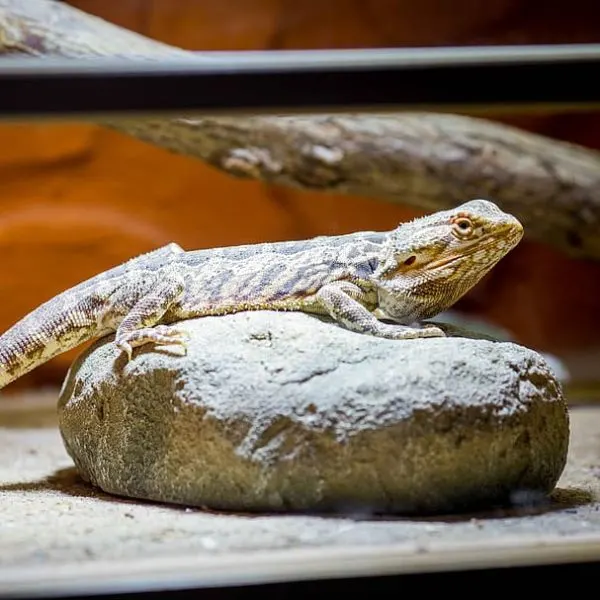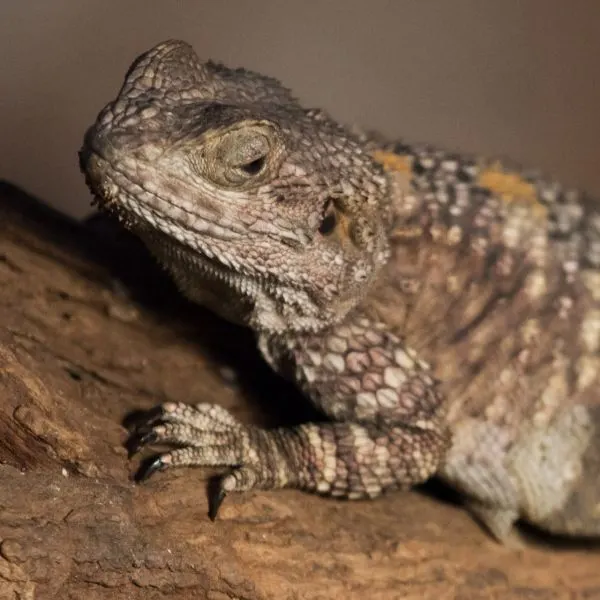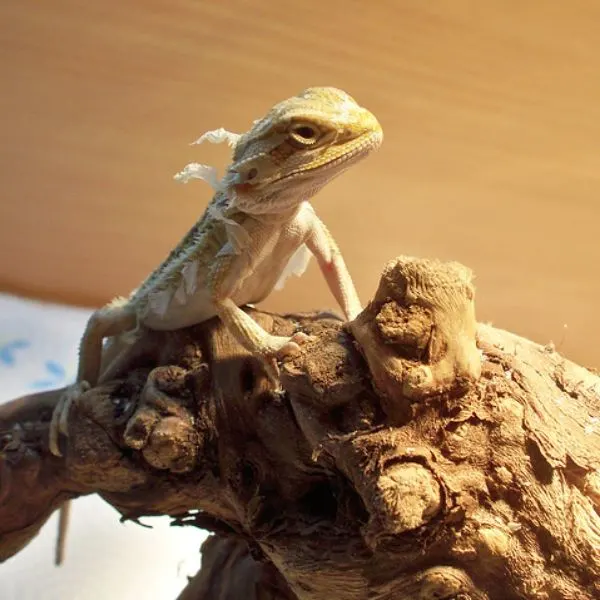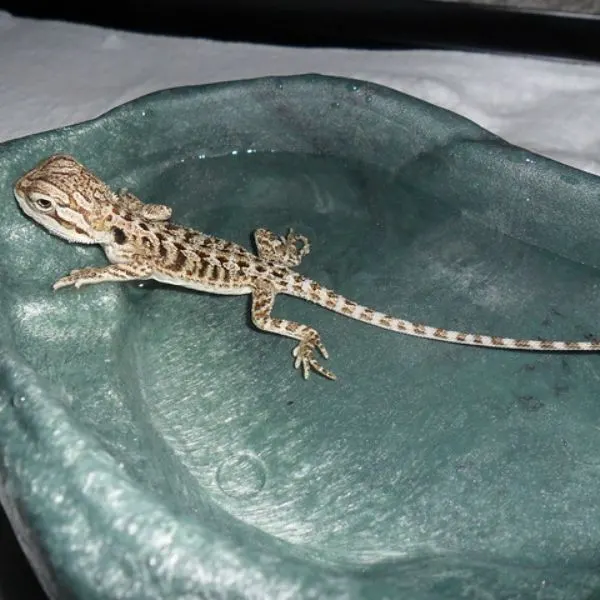You may even ask yourself, “Why is my bearded dragon sleeping in the corner?” Most of the time, if your beardie is sleeping in a corner, it could be something as simple as, “it was a good spot to take a nap.” If you’re a new beardie owner, you may have a lot of questions—I know I certainly did when I first got my two beardie babies.
Bearded dragons can be some of the quirkiest pets, and that quirkiness can really manifest itself during their sleeping habits. Some may like to sleep sprawled out against the glass, some may prefer dark hiding spots, while others sleep in some contorted, painful-looking poses.
Sleeping in a corner, or in strange positions is usually just what these little lizards do. If your beardie has been sleeping in the same corner for more than a day or continues to go to the same corner every time they nap, there could be different reasons why.
It could be a problem with the tank setup or lighting, it could be an illness or parasites, because of dehydration or impaction, or maybe because it’s crowded for your dragon. We will go over these possible reasons and more in detail and provide ways to remedy the situation.
Sit back, read on, and let’s get educated about why your bearded dragon is sleeping in the corner.
Table of Contents
Enclosure Setup
How you set up your pet’s enclosure can definitely have a huge impact on their mental health and might be the cause of them scrunching up in the corner of their tank.
Home Decorating Tips
Since we are touching on the enclosure a little bit, let’s go ahead and dive into a good, bearded dragon set-up. Since your beardie will be spending plenty of time in the enclosure, you’ll want to set it up well. Beardies need places to hide away sometimes, and they are semi-arboreal, meaning they like to climb a little bit.
They Like to Climb

Your pet’s enclosure needs things in it to keep them from being too bored such as this bearded dragon hammock, or branches for climbing that can be purchased at your local pet store. You can use branches from outside, but they will need to be cleaned and disinfected, and make sure they aren’t toxic to your beardie. Toxic branches can include but are not limited to yew, pine, cedar, and cypress wood.
They Like to Hide

You should also consider a place for your bearded dragon to hide. This can be accomplished by purchasing a hide-away they can also climb on, or by using excavator clay. This stuff is also a great substrate as it isn’t small enough to be accidentally consumed.
Excavator clay is a moldable substrate that can be shaped into burrows, raised basking spots, or left flat. When packed correctly it is smooth, so it doesn’t get accidentally swallowed.
If your beardie doesn’t have a good hiding spot it may be using the corner as a way to hide away. Burrows or somewhere to hide away helps prevent stress on your beardie as well. In the wild bearded dragons seek out hiding places to sleep or escape predators. Burrows are also ways to cool off if they start to get too warm.
If your beardie is “hiding” in the corner all the time, get a hollowed-out log, a pipe, or something they can hide in properly and see if that helps them feel better.
How’s the Lighting In There?

Is the light too bright or too close to the top of the enclosure? Does your beardie constantly close his eyes when basking? The light might be too intense, so he may hide in the corner to get away from the light.
It can be difficult to tell if your bearded dragon is getting too much light. They need a good balance of UVA/UVB rays, but it can’t be too intense or it can harm their eyes and skin. If your bearded dragon is hiding in the corner a lot, it could be that the bulb is too intense, or too close to the tank.
We could go into an entire article just on proper lighting, what is considered too much, or too little, what types to use etcetera. If it’s too bright in there, or the bulb is simply too intense, then when your beardie basks, it will do so with his eyes closed almost all of the time. If this is the case, find a smaller, less intense bulb. It may stop the corner hiding also.
You’re Hot and Then Cold

Let’s assume your dragon is living the bachelorette life, she’s enjoying her setup, everything is great in her life, but she simply chooses to sleep in the same corner. It may be that this area is comfortable for her. Bearded dragons can’t regulate their own body heat, so they have to move from spot to spot to warm up or cool off.
Use an infrared thermometer to check the temperatures inside your enclosure. Beardies need a basking spot, (100℉-110℉) a cool off section (70℉-85℉) and nighttime temps should be around 65℉ to 75℉.
You should use an infrared thermometer to check the temperatures of your enclosure and adjust as needed.
If the tank setup is too small, and the temperature is too hot or too cold, she may be hanging out in the corner to escape the temperatures, or maybe that area is just right. You really shouldn’t have to worry about hanging out in the corner unless she stays there more than 24 hours.
If you ever feel like something is not right with your pet, don’t hesitate to call your vet, they can answer all your questions and let you know when you should bring them in for care.
Another reason your dragon is sleeping in the corner and not moving is the area could be too cold. My female beardie, “Freida” likes it warmer than average. At 70℉ she slows to a crawl and doesn’t like to eat, but once I warmed the enclosure 5 more degrees, she became her usual self again.
When reptiles get too cold, they have a hard time moving around, so check the temperature your beardie is hiding in. If they start moving around after warming up, then maybe you have some spots in the enclosure that are too cool for them. Adjust your temperatures in the enclosure to keep your beardie warm and active.
Two’s a Crowd

Bearded dragons are essentially lifelong bachelors and bachelorettes. They spend the majority of their lives as solitary creatures. Yes, they do enjoy the company of their humans—they like our body heat and all the amazing treats—but beardies usually live their best lives alone.
If you have two or more bearded dragons inside one enclosure, it could be too crowded. To get away, he may situate himself in a corner to get away. These little introverts don’t like to be around others much. They may tolerate one another on occasion, but eventually, the sparks will start to fly.
Try separating your bearded dragons into their own, separate enclosures and see if that gets your corner-dweller moving about. If that doesn’t fix the problem, then read on because we have a lot more to get into.
Health-Related Issues
There are also health issues that might be causing a strange reaction from your little friend. Check on your pet often and watch closely for these possible concerns:
Stressed

Stress could also send your little beardie into a corner. It could feel safer there, especially if another bearded dragon is being a bit over-dominant.
Check to see if there is something on or near the other side of the enclosure that moves around a lot, makes a lot of noise, or is otherwise stressing him or her out.
If you notice something that your beardie doesn’t like, move it away, or relocate your dragon to a more relaxing area.
Braugh, It’s Like Brumation

Brumation is basically hibernation for reptiles. In the wild, bearded dragons can brumate for 3 to 4 months, and when the temperatures get cooler inside your house, this can signal the time to brumate. Not all bearded dragons go through brumation, it all depends on the dragon.
As long as there are no other causes for concern such as illness, abnormal poops, or skin discoloration, your beardie will go through brumation like a champ. Babies shouldn’t brumate though because they haven’t stored up enough food to fast for months, so if a baby looks like they are in brumation, or your adult bearded dragon appears sick and is brumating, contact your vet.
During this time, you can check on your beardie to make sure they are breathing and looking healthy. Just try not to wake them up too much if they appear to be in brumation, as this could mess up their internal clocks.
Continue to provide fresh food and water every day, because they may come out once every few days or so to eat a little bit. As long as your bearded dragon appears healthy, they will emerge from their brumation happy to see you and ready for their treats.
Here’s what a brumating bearded dragon looks like:
Shed Happens

Right before and during the shedding process a bearded dragon’s normal behavior can change quite a bit. He can become irritable and not want to be handled, he can get tired and listless, (sleeping in a corner) or he may become more active. It really depends on the dragon and how he is feeling at the time.
If you notice your bearded dragon is sleeping in the corner, and about to shed or is actively shedding, you can help the process along by bathing and soaking them. This is good all around because it helps to alleviate the irritation associated with shedding, it can moisturize the skin to help it come off easier, and bathing helps your beardie stay hydrated.
You can also mist them during the shedding process. Never try to help them with their shedding though. You could injure their skin, or cause tears in the skin if you pull on it. Let them shed on their own and the old skin should come off in time, on its own.
Parasites or Other Illnesses

Illness and parasites can cause your little pal to feel awful. These things can manifest in many ways such as lethargy, no energy, and sleeping more than normal. If parasites or illnesses are causing your beardie to slump into a corner, get them to the vet so they can get better.
Intestinal Parasites
Parasites can cause a lot of problems for bearded dragons. They are usually presented through their poop, so if you see abnormal poop, and your beardie is lethargic or stuck in a corner, get him or her checked out immediately.
Abnormal poops are anything runny, discolored, bloody, mucousy, very foul-smelling, or not pooping at all, like impaction or constipation. We have an entire article describing different parasites that can wreak havoc on your beardie’s health.
Some of the problems associated with intestinal parasites include loss of energy, loss of appetite, and can include sleeping in a corner. If parasites are suspected, you can read our article about them, but the main plan of action would be to take your pet to the veterinarian.
When the Gut Stops Moving, So Does the Dragon

Constipation can go from being uncomfortable to being dangerous for your beardie’s health. There are a lot of ways constipation can be caused and if it’s not severe it can be treated at home.
Symptoms of constipation include: no regular bowel movements, straining to poop but nothing comes out, lack of appetite, lethargy, and/or bulges or hard lumps in your beardie’s belly. When constipation gets serious it can cause back leg paralysis.
If your beardie is constipated, a warm bath is one of the best ways to help, followed by natural laxatives in the form of applesauce, pumpkin puree, or even a few drops of olive oil. If you suspect constipation is the cause of your beardie being stuck in a corner, and none of these home remedies help, you should contact your vet.
Impaction. Like Constipation, Only Worse

Impaction is when something creates a complete blockage in your bearded dragon’s gut. This can be caused by eating too much, trying to consume oversized food particles, accidentally consuming loose substrate, parasites, or some other internal cause.
Impaction can be pretty serious because it may not be able to pass the blockage on its own. Signs of impaction include the same symptoms as constipation, but also include feeling a hard lump in the belly, abdominal tenderness, regurgitation (vomiting), and if not treated, death.
What starts off as constipation can quickly lead up to impaction. Either way, impaction needs to be treated by your vet because it is harder to treat at home and comes with increased danger to the health of your pet.
Don’t Get Dehydrated

Since bearded dragons rarely drink water, dehydration can happen pretty easily. Beardies consume food to receive most of their water needs but you should always provide fresh water for them.
If a bearded dragon becomes dehydrated, it can become too tiring to move around much. The best ways to help prevent dehydration include feeding foods with lots of water content, misting your dragon and cage, and giving them a bath a few times a week.
Some high water content foods include:
- Watercress
- Bell peppers
- Zucchini
- Strawberries
- Mango
- Watermelon
FAQ
Do Bearded Dragons Need Light at Night?
A: No. Bearded dragons sleep best when it’s dark just like us. They should be getting about 12 hours of light during the day, but they need it dark to sleep their best.
Why is He Sleeping Against the Glass?
A: Bearded dragons will find some of the most uncomfortable-looking positions to sleep sometimes. As long as they still have a healthy appetite, are normally active, and are happy, just enjoy some of the strange positions they put themselves in.
Do Blankets Keep Bearded Dragons Warm?
A: No. Bearded dragons are cold-blooded. They do not produce body heat, so a blanket is not able to keep the heat on your beardie. A heat lamp, under-tank heat pad, or heated rock should provide the necessary heat for your bearded dragon.
Conclusion
Whether you’re a new bearded dragon owner or a long-time veteran, you want the best for your pet. Bearded dragons have some quirky habits and are full of character which makes them some of the most endearing scaled pets out there.
If you find your bearded dragon sleeping in a corner all the time, assess to see if she is going into brumation, possibly has parasites or some other illness, or is stressed because she feels she has no room. You could also check the lighting and temperature of the enclosure to see if that has something to do with it.
Sleeping in the corner could be something as simple as he was tired and found the corner to be comfortable. We hope this article answers your question as to why is my bearded dragon sleeping in the corner, but if you still have questions, or if your beardie seems to be suffering from an illness of any sort, please reach out to your vet for further instructions.
More Bearded Dragon Articles
- What causes sunken eyes in a Bearded Dragon?
- Why is my Bearded Dragon sleeping in the corner?
- Why is my Bearded Dragon aggressive?
- Difference between a leopard gecko and a bearded dragon
- Why is my Bearded Dragon hiding in its cave?
- Do Bearded Dragons fart?
- Do Bearded Dragons get depressed?
- Parasites and Bearded Dragon
- Why is my Bearded Dragon turning white?
- Bearded Dragon Poop how to tell what’s healthy
- How to clean a bearded dragon tank
